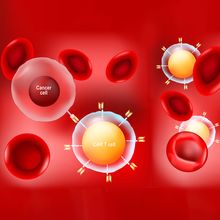Login
Subscribecancer

Breast Cancer Cells Churn Out Cholesterol to Fuel Metastasis
Alejandra Manjarrez, PhD | Feb 4, 2022 | 4 min read
A study uncovers a novel connection between the biomolecule and cancer progression.

Ten Years On, CAR T Cell Recipient Is Still Cancer-Free
Jef Akst | Feb 3, 2022 | 2 min read
First, the genetically engineered cells became CD8+ killer T cells that wiped out his leukemia. Then they transformed into a stable population of CD4+ helper T cells that continue to circulate in his body.

LabTalk Podcast - Hijacking Genes: Uncovering the Cause of Lineage Ambiguous Leukemia
The Scientist | 1 min read
Chromosomal rearrangements reposition influential and often overlooked non-coding elements in the genome to hijack genes and cause cancer.

Modified Salmonella Revs Immune Response, Combats Tumors in Mice
Natalia Mesa, PhD | Feb 3, 2022 | 5 min read
When coated with positively charged particles, the bacteria shuttled antigens out of tumors and activated the immune system, a study finds.

Cancer Researcher Beatrice Mintz Dies at 100
Natalia Mesa, PhD | Jan 20, 2022 | 2 min read
Mintz’s experiments over her six-decade career were foundational to cancer and genetics research.

Understanding Cancer Evolution Through the Lens of Single Cell Genomics
The Scientist | 1 min read
Nicholas Navin and Lars Velten discuss sampling, sequencing, and tracing single cells to study how cancer cells adapt to various environments.

Strange DNA Structures Linked to Cancer
Sophie Fessl, PhD | Jan 19, 2022 | 3 min read
A study reveals a connection between the loss of enzymes responsible for removing methyl groups from DNA, nucleic acid knots, and cancer development in mice.

Turning Toxoplasma Against Cancer
Annie Melchor | Jan 3, 2022 | 9 min read
Several research groups have found that Toxoplasma gondii infection can ramp up antitumor immune responses in mice. Can the single-cell parasite be used to develop safe treatments for humans?

Understanding Immune Cell Function in Cancer
The Scientist and Isoplexis | 1 min read
Explore how scientists characterize immune cell functional behavior in response to cancer, and how they harness this information for therapeutic purposes.

The Common Mouth Microbe That Keeps Popping Up in Tumors
David Adam | Dec 15, 2021 | 6 min read
Lab studies link the oral bacteria Fusobacterium nucleatum to cancers from the gut to the head and neck. Could targeting the microbe tackle tumors?

Our Favorite Cancer Stories of 2021
Amanda Heidt | Dec 9, 2021 | 4 min read
This year revealed just how much scientists have learned about the disease, from how animals become naturally cancer-resistant to how tumor cells harness extracellular DNA to develop rapid drug resistance.

Understanding the Complexity of Cancer with Cryo-EM
The Scientist and Thermo Fisher Scientific | 1 min read
Explore how researchers use cryogenic electron microscopy (cryo-EM) to identify how mutations affect protein signaling and function through structural or conformational changes.

Study Finds Reproducibility Issues in High-Impact Cancer Papers
Catherine Offord | Dec 7, 2021 | 7 min read
Researchers involved in an eight-year project to reproduce the findings of more than 50 high-impact papers struggled to get enough information to even carry out most of the experiments.

Cancer Cell Nanotubes Hijack Mitochondria from Immune Sentinels
Sophie Fessl, PhD | Nov 30, 2021 | 3 min read
The mitochondria stolen via these tiny connections give tumor cells a metabolic boost while the T cells are left weakened, according to in vitro experiments.

How Cellular Heterogeneity Drives Immune Responses
The Scientist Creative Services Team in collaboration with 10x Genomics | 2 min read
An expert panel will discuss how single cell multiomic techniques shed new light on immune cell heterogeneity and immune function.

Over-the-Counter Antihistamines Could Help Against Cancer
Alejandra Manjarrez, PhD | Nov 24, 2021 | 3 min read
The binding of histamine with one of its receptors within the tumor environment makes cancer cells more resistant to immunotherapy, according to a new study. Blocking that binding could improve responses to treatment.

Cell Diversity Could Spell Trouble for Animal Models of Cancer
David Adam | Nov 19, 2021 | 3 min read
Tracking human cancers in mice shows some unexpected cell changes that could undermine translational research.

The Scientist Speaks - Homing in on New Anticancer Targets
Sejal Davla, PhD | 1 min read
Jason Sheltzer discusses cancer mechanisms leading to drug resistance and new approaches to find drug targets.

Training Immune Cells to Be Cancer Killers
Aparna Nathan, PhD | Nov 12, 2021 | 4 min read
A career-altering experience as a cancer patient motivated one researcher to design more potent immunotherapies.

Can mRNA Vaccine Momentum Propel Tumor Immunotherapies?
Aparna Nathan, PhD | Nov 12, 2021 | 4 min read
A guide to mRNA-based cancer vaccines and where they’re headed next